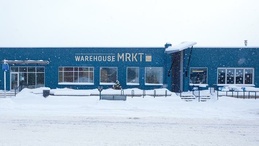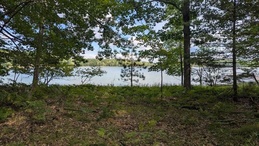Biodebate
April 11, 2010
BioDebate: A point/counterpoint on the biomass issueBy Anne Stanton
A decision on a proposed $30 million biomass gasification plant in
Traverse City will come to a head on April 20 when the Traverse City
Light and Power (TCL&P) board votes on whether to proceed. It’s part
of the utility’s plan to achieve a 30% renewable energy portfolio by
2020.
The plan includes a combination of solar, wind power, landfill gas,
and a 10-megawatt biomass plant. The utility has talked of building
three such plants. The first would be built in a business park off
Parsons Road; it would burn wood and perhaps other fuel crops to
generate electricity and waste heat, which would be piped to nearby
businesses.
Environmentalists and newspaper editorials have repeatedly urged the
utility to slow down its decision while all alternatives are fully
examined. Yet in a third public meeting held last week, very little
was said about alternatives, including the emerging idea of using a
combination of wind power supplemented by flexible natural gas to
provide 24/7 base power. TCL&P presented results of an informal poll
from the first two public hearings based on dots (votes), which
reflected wind energy as the top choice (63 in favor), outnumbering
biomass at 19.
The utility brought together experts from around the state at last
week’s meeting to explain why biomass was ideal for Northern Michigan.
A DNR official explained that the new growth of trees was twice the
amount cut down each year on state land.
A group of citizens who oppose biomass is convinced that the utility
has its mind fully made up and is going on the offensive. It formed a
new environmental group to stop biomass not only here, but throughout
Michigan, called Michigan Citizens for Energy, the Economy, and the
Environment.
This week, the Express posed the most frequently asked questions about
biomass. Answering them are Ed Rice, TCL&P’s executive director, and
M’Lynn Hartwell, co-founder and senior researcher with the Jobs and
Energy Group, a Traverse City based think-tank providing research and
information about new clean technology and green tech jobs in
Michigan.
1. Is there a place in the state or country that we could visit that
has a biomass gasification plant like the 10-megawatt facility
proposed for Traverse City?
Ed Rice: There are several biomass gasification power plants in North
America and Europe. None are in Michigan, though we have all the
necessary conditions for a successful project including abundant
feedstock. There are several ~10 MW biomass gasification plants in
Canada and several other larger ones in Finland and Sweden.
Scandinavian countries have stringent environmental regulations.
Additional details can be found in the 2007 NETL Gasification World
Database published by the US Department of Energy.
(http://www.netl.doe.gov/technologies/coalpower/gasification/database/database.html)
M’Lynn Hartwell: TCL&P plans to hire HTI, Inc., a downstate firm, to
build this plant, yet there is no evidence it has ever built a
facility of this magnitude. It could end up like the collapsing
septage plant—a giant money hole. HTI has designed a small plant for
a turkey CAFO (concentrated animal feeding operation) where they
gasify 1.5 million dead turkeys and 70,000 pounds of turkey litter to
generate heat for its buildings and to also generate 12,000 kilowatts
of electricity. It’s time for TCL&P to talk turkey, and show us even
one plant, built by HTI, like the one proposed for Traverse City and
has successfully operated. Otherwise, it’s like signing a blank check!
2. This country wants to reduce carbon dioxide spewed by coal-fired
power plants to slow down climate change. Another deeply troubling
development is the acidification of the ocean, threatening to make the
water uninhabitable for mussels, clams, and krill. Scientists conclude
in a study published in Nature Geoscience (2/10) that rising carbon
dioxide levels in the atmosphere are to blame. Please address the
biomass alternative and its impact on these two problems.
Rice: The wood biomass gasification plant that TCL&P is considering
produces significantly less carbon dioxide than generating electricity
from coal. Acid rain is caused by SO2 (sulfur dioxide) and NOx
(nitrogen oxide). The Clean Air Act requires the installation of air
pollution control equipment such as scrubbers to reduce SO2 and SCRs
(selective catalytic reduction) to reduce NOx. Wood biomass
gasification plants produce a tiny fraction of SO2 and about half the
amount of NOx as coal plants. Bottom line: a wood biomass
gasification plant would be a much more environmentally sensitive
alternative to generating electricity than coal generation.
Hartwell: Carbon emissions from coal and biomass are roughly equal,
not less as TCL&P claims.* So the question becomes: do newly planted
trees absorb carbon from biomass burning with no effect to the
atmosphere? Not when you consider time, and we don’t have time. It
takes 30 years for the planet to absorb 50% from the carbon burst of
burning a tree today, hundreds of years for the next 30%, and
thousands of years for the remaining 20%.** Ignoring the element of
time is an insult to the public’s common sense.
3. What’s the cost of biomass versus wind, solar, natural gas, and
hydro-electric power? To simplify, what is the cost per kilowatt hour
(kWh) compared to what we are paying now for coal power?
Rice: The Integrated Resource Plan (IRP), developed by R.W. Beck for
TCL&P, provides an average present value (PV) cost of base-load
resource options as follows: wood biomass (10.6 cents/kWh), natural
gas combined cycle (15.0 cents/kWh), coal (10.6 cents/kWh) and coal
with carbon sequestration (12.6 cents/kWh). The IRP provides a PV
cost of peaking resource options as follows: wind (13.6 cents/kWh),
solar (46.7 cents/kWh) and natural gas combustion turbine (13.8
cents/kWh). TCL&P is currently paying about 5.0 cents/kWh for the
power received from coal contracts signed in the early 1980s.
Hartwell: I use the 2009 Lazard Levelized Cost of Energy national
study, the industry bible. Natural gas (combined cycle) is one of the
cheapest sources at 6.9 to 9.6 cents/kWh; it’s clean, emits half the
carbon as coal, and could bridge us to wind and solar, which gets
cheaper all the time. Biomass costs 6.5 to 11. cents/kWh; coal was 7.8
to 14.4 cents cents/kWh; solar, 8.7 to 19.6 cents cents/kWh. Wind was
the clear winner at 5.7 to 11.3 cents/kWh, plus it’s plentiful and
pollution-free. The study, “Energy Self-Reliant States,” says with
better infrastructure, Michigan could produce 259% of its energy
without consuming any coal or biomass.
4. Some people feel that stripping the forest of everything that
normally rots and replenishes the soil is a bad idea. Others think
hauling away waste wood makes for a healthier forest. What do you
think?
Rice: TCL&P does not promote the idea of stripping the forest of
everything that rots (all organic matter). It is not a wise and
sustainable use of our natural resources. “Hauling away waste wood”
or using woody biomass as a forest product (fuel) can be a wise use of
our forest resource if done sustainably as part of a professional
forest management plan. TCL&P plans to use only wood from forests
that are approved and certified sustainable by the Michigan Public
Service Commission as explained in Public Act 295.
Hartwell: Our forests are the lungs of the earth. We should be
planting trees, not cutting them down. Trees take carbon out of the
atmosphere and release the oxygen we need to live. Organic matter from
trees breaks down in soil as nitrogen, phosphorus, and humus, which
plants need. Decaying plant matter keeps soil loose, porous and
permeable and increases water -holding capacity. Haul away organic
matter to burn as biomass and our soil becomes depleted “sand” that
can grow nothing. No forest ecologist believes that “hauling away
waste wood makes for a healthier forest,” as TCL&P claims. Biomass
harvesting disrupts wildlife and destroys animal habitat.
5. Do you believe the lack of state coordination of the number and
location of biomass plants could damage our state and privately owned
forests (privately owned woods make up 49% of Michigan’s 20 million
acres of forests; state land is 21% or 4 million acres)?
Rice: State forest lands are managed for long term sustainability
regardless of any particular industry or forest use. Many private
forest owners utilize professional management services that ensure
similar long-term sustainable forest management. If TCL&P pursues
construction of a wood biomass gasification plant it will be
accompanied by strong sustainable forestry management plans and
practices to ensure that forestry ecology is strengthened while
simultaneously ensuring a steady supply of fuel at prices that result
in competitive electric rates for our customers.
Hartwell: Europe thought they could do biomass sustainably, too, and
now their forests are just about gone. Belgium, Holland and Sweden
buy wood from Canada and Brazil. Texas is going to ship $27 million
worth of wood chips to Germany next year for renewable energy. As for
Michigan, one independent forest ecologist states we are “rushing
willy-nilly to support these proposals.” We have no limit on the
number of biomass plants. Active proposals in northern Michigan total
162-megawatts of biomass fueled energy. This equates to a clear-cut of
10,000 acres each year for each megawatt—that’s equal to new growth
from 1.62 million acres.
6. Are air pollution, odor, traffic, and noise from the plant
problematic? Why or why not?
Rice: The wood biomass gasification plant considered by TCL&P will fit
into the landscape where it is built, which is planned for an
industrial park. It will have minimum smell and noise in the direct
proximity of the plant. It will receive truckloads of wood chips and
wood waste for fuel. It will have modest air emissions legally
permitted under the state’s air quality law. The amount of truck
traffic to the plant is equivalent to the truck traffic that serves
one of our grocery stores or one of our other industrial plants.
Hartwell: Biomass plants, like factories, are noisy. Wood-chips
mildew, rot, smolder and smell. In addition to the mechanical sounds
of unloading wood to burn, a 10-megawatt power plant will have around
a dozen semi-truck deliveries each day driving near residential
streets with more semi-trucks hauling ash out. Are we about to screw
up the environment in the same way we screwed up the economy? Economic
interests are trumping intelligent thinking, because there is a
strange loophole in the Kyoto Protocol rules that currently allows a
tree to be burned without having to account for the carbon released
when a tree is used as fuel.
7. How do you feel about the proposed location for the biomass plant?
Rice: The location of the plant was selected to take advantage of
combined heat and power (CHP) that doubles the efficiency of the plant
by generating hot water to heat nearby businesses and institutions.
CHP has the additional advantage of displacing traditional fossil
fuels as an energy source in those buildings. The proposed plant
location is an industrial park, at the site of a former iron foundry,
and is consistent with industrial use. There is an opportunity to
locate the plant out of town, but we would lose significant efficiency
of CHP and incur distribution line losses.
Hartwell: Next to our airport is nearly as bad as the old coal plant
downtown on West Bay. As a pilot, I would not want biomass power-plant
emissions obscuring my visibility of the runway. To make things worse,
this is near a residential area, next to our TART recreational trail.
People are walking, riding their bikes, pushing their strollers, and
skating on their roller-blades in pursuit of a healthy lifestyle.
Finding funding and support for the pipe dream TCL&P refers to as
district heat (piping waste heat ordinarily sent into the atmosphere
as hot steam) is extremely expensive and logistically improbable in
Traverse City.
8. A lot of people believe that a conservation program could save as
much energy as a 10 megawatt biomass plant could provide? Agreed? How
would that work?
Rice: TCL&P has been a leader in energy efficiency, providing energy
audits for businesses and residents for more than 10 years to
recommend efficiency measures and recently increased our efforts in
conjunction with Act 295. Our load forecast includes an aggressive
energy efficiency program that reduces our capacity needs by 10MW. If
we are able to expand our energy efficiency effort to be the most
aggressive in the nation, we would be able to reduce our capacity
needs by another 10MW. However, even after these efforts, our
projections show that we will need at least an additional 20MW of
capacity.
Hartwell: TCL&P has a lot of business customers, therefore, business
participation in any conservation and efficiency program would be
vital to achieve success. I would suggest that we invest more
resources in making our community more efficient, rather than adding
local generating capacity and pollution. What if TCL&P invested $10
million in a zero-interest infrastructure improvement program, where
half of the savings would be kept by the rate payer, and half of the
savings were paid back to TCL&P to reinvest over and over again? We
need to find the community and political will to make smart
investments beyond energy generation.
9. Ed, how much has Traverse City Light and Power spent in total on
the public relations effort to influence and inform public opinion on
biomass? M’Lynn, how much are you and/or the regional environmental
groups spending to oppose this.
Rice: Our efforts have not been a public relations effort directed to
influence and inform public opinion – our efforts have been to prepare
information on an incredibly complex problem and to reach out to the
community to seek their input. To date, we have spent approximately
$45,000 on that effort. It doesn’t cost much to have people come out
and say “no” or “not in my back yard.”
Hartwell: Not one single penny has been received by me to support my
work on this issue. My website http://JobsAndEnergy.com, is paid from
my personal funds. I do this because of my love for this place I call
home. Environmentalists have brought in forest biologist Dr. Rachel
Smolker, who accepted no speaking fees and paid for her own travel.
NMEAC spent $35 for the library room and video projector plus room and
board for she and her young son during their visit. Environmentalists
who work for Sierra Club and MLUI just get their regular salaries.
Activist Jeff Gibbs volunteers and bought Dr. Smolker breakfast.
10. Do you feel the public is hearing the truth about biomass?
Rice: We have been disappointed in much of the information that
critics are using to misinform and distort the utility’s local
renewable energy plan. These are the real facts that the community
needs to know. We have two independent studies and discussions with
state forestry officials that identify significant wood resources
available to fuel a 10MW biomass plant without any harm to the forest.
The ash generated from the process is not toxic. The forests will not
be denuded. Generating clean renewable energy with local fuels has
tremendous advantages over burning coal, from cost to emissions to
generating local jobs and expanding our economy.
Hartwell: The “independent” consultants hired by TCL&P work for firms,
which are paid tens of millions of dollars to develop and promote the
biomass industry. Even the biomass association president admits
biomass is only viable with tax breaks and government subsidies. TCL&P
literature says “hauling away waste wood makes for a healthier forest”
with no citations (and no truth!). TCL&P’s lists five different fuel
sources in its brochure, yet doesn’t mention standing timber. That’s
“flat-out dishonest,” according to forest ecologist Marvin Roberson.
Ash is toxic, and includes arsenic, cadmium, chromium, copper, lead,
and mercury. (Source: Energy Sources, Part A: Recovery, Utilization,
and Environmental Effects, Volume 25, Issue 5)
* “Replacing fossil fuels with bioenergy does not by itself reduce
carbon emissions because the carbon dioxide released by tailpipes and
smokestacks is roughly the same per unit of energy regardless of the
source. If unproductive land supports fast-growing grasses for
bioenergy, or if forestry improvements increase tree growth rates, the
additional carbon absorbed offsets emissions when burned for energy.
However, harvesting existing forests for electricity adds net carbon
to the air. That remains true even if limited harvest rates leave the
carbon stocks of regrowing forests unchanged, because those stocks
would otherwise increase and contribute to the terrestrial carbon
sink.” Science, October 23, 2009.
** Source: U.S. EPA , Vol. 74, No. 78 / Friday, April 24, 2009,
http://edocket.access.gpo.gov/2009/pdf/E9-9339.pdf
Trending

Farm to Glass with Ethanology
When Elk Rapids distillery Ethanology committed to locally-sourced ingredients for their products, it seemed like they&rsquo… Read More >>
MRKT HLDY SHPPNG, aka Warehouse MRKT Holiday Shopping!
Shop the latest from local makers and vendors at the Holiday MRKT Share at Warehouse MRKT in TC, Saturday, Dec. 20, from 10a… Read More >>
Men and Ugly Sweaters
Those two things don’t always go together, but on Dec. 19, you’ll see both out and about in Petoskey and Harbor … Read More >>


